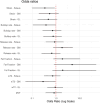Dynamic MR of Muscle Contraction During Electrical Muscle Stimulation: Potential Application to the Evaluation of Neuromuscular Diseases
- PMID: 41248684
- PMCID: PMC12623070
- DOI: 10.1002/nbm.70176
Dynamic MR of Muscle Contraction During Electrical Muscle Stimulation: Potential Application to the Evaluation of Neuromuscular Diseases
Abstract
Thanks to the rapid evolution of therapeutic strategies for muscular and neuromuscular diseases, the identification of quantitative biomarkers for disease identification and monitoring has become crucial. Magnetic resonance imaging (MRI) has been playing an important role by noninvasively assessing structural and functional muscular changes. This exploratory study investigated the potential of dynamic MRI during neuromuscular electrical stimulation (NMES) to detect differences between healthy controls (HCs) and patients with metabolic and myotonic myopathies. The study included 14 HCs and 10 patients with confirmed muscular diseases. All individuals were scanned with 3 T MRI with a protocol that included a multi-echo gradient echo sequence for fat fraction quantification, multi-echo spin-echo for water T2 relaxation time calculation, and 3D phase contrast sequences during NMES. The strain tensor, buildup, and release rates were calculated from velocity datasets. Results showed that strain and strain buildup rate were reduced in the soleus muscle of patients compared to HCs, suggesting these parameters could serve as biomarkers of muscle dysfunction. Notably, there were no significant differences in fat fraction or water T2 measurements between patients and HCs, indicating that the observed changes reflect alterations in muscle contractile properties that are not reflected by structural changes. The findings provide preliminary evidence that dynamic muscle MRI during NMES can detect abnormalities in muscle contraction in patients with myotonia and metabolic myopathies, warranting further research with larger, more homogeneous patient cohorts.
Keywords: dynamic MRI; muscle; neuromuscular diseases; neuromuscular electrical stimulation.
© 2025 The Author(s). NMR in Biomedicine published by John Wiley & Sons Ltd.
Conflict of interest statement
Ning Jin is an employee of Siemens Healthineers.
No other author has any conflict of interest to report related to the subject of this manuscript.
Figures





References
MeSH terms
Grants and funding
LinkOut - more resources
Full Text Sources
Medical

